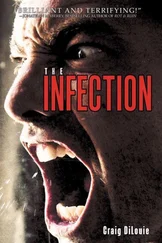“I’d forgotten, Dr. Petrova,” Hardy blusters, turning red. “I’m sorry.”
“In fact,” she says, collecting herself with a visible effort, “I believe I have a unique perspective on just how serious it really is based on my test results.”
“All right, all right,” he says. “I give. You’ve got your five minutes.”
We are trying to cure the wrong disease
Petrova takes a deep breath and tells Hardy about what she found.
The Lyssavirus is transmitted like influenza, entering the body through the respiratory tract and attacking the lungs. The most common cause of death is a cytokine storm, a situation in which the body’s immune system turns on itself. When the body encounters an invader, cytokines summon armies of immune cells to fight the infection. Normally, they stop, but sometimes, when a new virus is encountered, they can’t. The resulting storm of immune cells lays waste to everything, damaging body tissues and organs, blocking airways and drowning the body in its own bloody snot. The malfunctioning immune system kills the body it was designed to protect.
In advanced cases, Lyssa enters the nervous system and attacks the brain, resulting in progressive viral encephalitis—steadily worsening inflammation of the brain—which kills its victim in less than a week. It specifically targets the limbic system, which governs a person’s emotions, motivation and behavior. The result is artificial rage, popularly called Mad Dog Syndrome.
Laboratories across the country are trying to crack the disease and produce a vaccine—some competing, some collaborating—under direction from the Centers for Disease Control in Atlanta. Normally, Hardy and Petrova’s laboratory facility, a Biosafety-Level Two lab located in the heart of Manhattan, would not even be working on a virus as dangerous as Lyssa, but it is already in the community, so there would be no real threat if it escaped the lab. And besides, the CDC and USAMRIID are desperate.
Hardy’s team is actually getting close to their objective. If starvation and the mob and the brownouts and the cold don’t finish them first.
“This I know,” Hardy says. “Tell me what I don’t know.”
“My research has led me to the conclusion that the advanced dementia variant of the disease—what people call Mad Dog syndrome—is actually a separate disease.”
In fact, she continues, the Mad Dog virus appears to have preceded the HK Lyssa virus. It is HK Lyssa’s primitive ancestor. HK Lyssa is essentially a benign mutation of the Mad Dog virus that allowed it to survive by spreading more easily among humans.
“But in a few cases, HK Lyssa attacks the brain,” she adds. “Once in the brain, the virus displays a remarkable trait: It reverts back to its primitive ancestor, the Mad Dog virus. HK Lyssa is therefore a—what is the term—Trojan Horse for Mad Dog. As you can see, we are wasting our time here trying to cure HK Lyssa.”
“Hell, we’ve already isolated the bastard in vitro and we’re working up a complete genetic characterization,” says Hardy. “Don’t be too hard on us. We have a ways to go, but we are getting close.”
“What I am saying is we are trying to cure the wrong disease,” she says.
“Bullshit,” Hardy says flatly.
She stomps her right foot in frustration and says, “Oh!”
“What you’re saying is fascinating, but academic. You said yourself that Mad Dog comes from Lyssa, so if we cure Lyssa, we cure Mad Dog.”
“Doctor, listen to me carefully,” Petrova tells him. “You know that Mad Dog and HK Lyssa come from the Lyssavirus family. Rabies is in that same family. While genetically very different, the symptoms are similar. The Mad Dog virus appears to be perfectly designed to transmit itself through bites and infected saliva. This is why the Mad Dog victim is so aggressive. He is compelled to seek out and infect others. This is an entirely new vector of disease transmission and, in my opinion, poses the greater threat.”
Hardy grunts, interested now. “How does the virus operate?”
“When a Mad Dog bites an uninfected individual, the virus enters the body through the bite. It attacks the nerves and, undetected by the immune system, travels to the spinal cord. From there, it is mainlined to the brain. By the time the immune system detects the virus, it is too late. Very similar to rabies.”
Hardy scratches his head in wonder. There were anecdotal reports of Mad Dogs transmitting illness through their saliva, but no real research in that area. The medical research community has been focused entirely on Hong Kong Lyssa as an airborne, flulike illness, and there were so few Mad Dogs. . . .
“What’s the incubation period?” he asks her.
“It could be remarkably fast. My results suggest infection occurs within one hour and symptoms manifest several hours later.”
“You mean weeks.”
“No. I mean hours.”
“But that can’t be,” he says, almost laughing. “It’s impossible. Isn’t it?”
“I have a hypothesis about the incubation cycle at this point,” she tells him.
“But it’s preposterous! If the disease is closely related to rabies and is a latent feature of HK Lyssa, then one would expect a period between exposure and becoming symptomatic to be more like its rabies cousin—anywhere from twenty to sixty days.” He blinks. “Wait—what is your hypothesis?”
“I believe the disease may have been bioengineered and that is why it is so efficient.”
Hardy breaks into a sweat. “Oh, Jesus. A terrorist weapon?”
“I do not know, obviously. But that is not important right now. What is important is given the aggressive mode of transmission and the lack of immunity in the population—even those who have caught Lyssa and recovered—the disease has a transmission factor that is likely equal to or greater than R2.”
“Exponential spread. Of a disease that is transmitted through aggressive biting.”
“It’s almost impossible to confirm without field data,” Petrova says.
“And then there’s the incubation period of several hours.”
“Yes. As I was saying to you, the implications of my findings are naturally quite significant.”
“You can say that again,” Hardy snorts.
“I would like to speak to some epidemiologists to discuss with them what they are learning in the field. Meanwhile, we will need to shift resources from curing the version of the disease transmitted by sneezes to the version transmitted by bites. Obviously.”
Hardy rubs his hand over his stubbled face, staring over her shoulder in a daze. “I mean, you’re kind of talking about the end of the world.”
“You know my background. Ten years working with viruses like Ebola, Marburg, Lassa Fever. I am hardly an alarmist. I am only interested in facts. And the facts tell us that the Mad Dog strain is now taking over from its descendant because its victims are now spreading exponentially in the population. That is the disease we need to cure.”
The blood suddenly drains from Hardy’s face.
“Oh, God,” he says, remembering. “Amy!”
Taking out his cell phone, he hurriedly punches a phone number.
“Yes! It’s ringing,” he says, pacing nervously. “Come on, come on. Pick up the phone.” He suddenly feels an irrational rage at his daughter for making him worry. “I got her voicemail.” His tone suddenly changes, becoming calm and smooth, a father’s voice. “Hey honey, it’s Dad. Just calling to make sure you’re okay. Give me a shout when you get a minute, all right? I love you.”
Outside the Institute, the country is falling apart because of the epidemic. Nearly twenty percent of the country’s workforce is sick, consuming resources and producing nothing. And the numbers keep growing while supplies keep dwindling. Food and gas are being rationed, world trade has ground to a halt, the economy is crashing, and prices for everything from cigarettes to toilet paper are skyrocketing. Most states have declared martial law under the Emergency Powers Health Act.
Читать дальше












